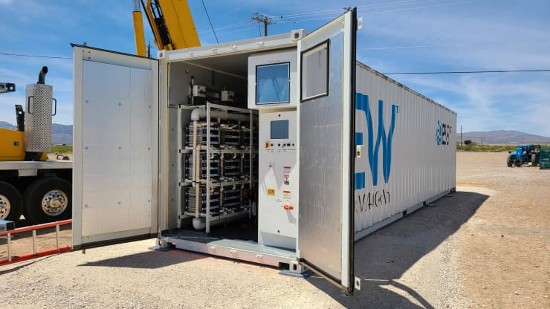The battery technology in your laptop, smartphone, and electric vehicle is almost exclusively based on lithium-ion. But batteries to back up utilities, commercial and industrial sites, and microgrids are a whole other matter. That’s where iron becomes a substitute for lithium states ESS Inc., a ten-year-old company that has developed low-cost, iron-flow technology for long-duration energy backup requirements of up to 12 hours per battery pack.
Iron-flow technology combines iron, salt, and water as the electrolyte to produce a reliable electricity storage repository suitable for installations requiring flexible energy capacity.
ESS, an Oregon-based company, is all about long-duration energy storage. And better yet, the batteries aren’t made from materials that are expensive like cobalt and nickel. Its iron-flow batteries are large, unlike lithium-ion technology. The electrolyte which is water is pumped continuously throughout the battery’s charge-discharge cycles. The typical housing is a shipping container. And when compared to lithium-ion at $350 per kilowatt-hour (kWH) cost, ESS batteries deliver $200 kWH. To add capacity at an existing installed site, add more electrolyte which comes with an incremental cost of as little as $20 kWH. Talk about savings.
Flow battery technology has been around since NASA built its first one back in 1980. NASA saw water electrolytes as being safer than chemical options. The agency’s history with fire onboard the first space-ready Apollo capsule in 1967 and the short-circuit fuel-cell explosion on Apollo 13 in 1970 during its voyage to the Moon made it risk-averse to any potentially hazardous chemicals or materials that could endanger spacecraft systems. At the time in the early 1980s, lithium-ion technology was still pretty new and seen as far more hazardous particularly because of potential overheating. The NASA Goddard Space Flight Center, therefore, began experimenting with a number of battery technologies and materials including flow technology that sued nickel, lithium, cobalt, cadmium, vanadium, zinc and other materials. As I reviewed the publicly available NASA documents from that period, iron as a material didn’t seem to be included in the agency’s tests.
The ESS battery which has evolved to its present commercial state over the past decade contains four components: two electrodes, an electrolyte and a separator. A pump keeps the electrolyte flowing as the charged particles shuffle between the electrodes while the separator prevents a short circuit. And each battery comes neatly packed into a shipping container which can be daisy-chained to other containers to expand energy capacity at any site. That’s what makes ESS suitable for large utility and industrial sites.
Not only is capacity easy to increase but the battery technology is sustainable and greener than any other comparable flow, chemical or solid-state alternative on the market today. Each ESS battery has a 25-year operating life, contains completely recyclable materials, and contains 100% reusable electrolytes. The batteries perform in heat and cold, start up in a second and offer unlimited discharge and recharge cycles. In recent lifecycle analysis testing done at UC-Irvine, in California, the iron-flow technology ranked first in six of eight impact categories when compared to a range of battery technologies featuring lithium, nickel, cobalt, aluminum, iron phosphate, and vanadium-redox materials.
In the last week, ESS started trading on the New York Stock Exchange (ticker symbol GWH) as the first publicly listed long-duration energy storage company in the United States. The company’s initial investors included Bill Gates and Softbank, the Tokyo-based technology giant. One of the latter’s subsidiaries, SB Energy Corp., is the latest purchaser of ESS technology, a $300 million purchase of 2 Gigawatt-hours of iron-flow batteries, enough over the next five years to power 50,000 homes every day.
Long-duration energy storage is critical to transitioning to an electric grid largely based on renewable energy sources. The ability to provide up to 12 hours of battery backup from one of ESS’ battery warehouses makes intermittency from renewables go away. Staging multiple iron-flow battery warehouses to come online whenever there is a drop-in renewable electricity will make the zero-emission energy grid viable much sooner than 2050. Utilities need to start manning up.
















